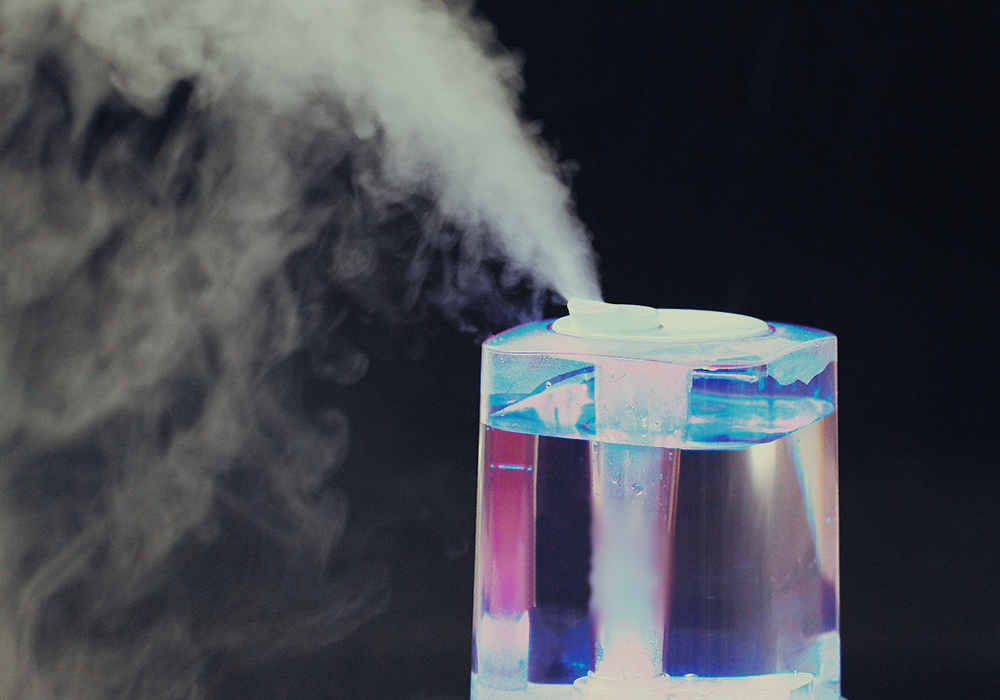When you turn on a humidifier, you could be sending more than just water vapor into the air. While we don’t know the precise degree to which contaminants in water are aerosolized and inhaled, we do know that humidifiers can create a cloud of particles in indoor spaces.
So, should you think twice before turning on that humidifier? Read on to learn more.
What are the different kinds of humidifiers?
Decades ago, people used two basic types of humidifiers to add moisture to house air:
- Steam Humidifier. A steam humidifier was little more than a plastic kettle that boiled water and cast vapor into the air. While this was effective in adding humidity to the environment, it was somewhat dangerous with young children around (whose respiratory ailments were often the reason for seeking humidification).
- Drum Humidifier. This technology involved a pad or wick, a water container, and a fan, sometimes configured as a rotating drum. The pad soaked up water, and as air blew through the pad, humidity was released into the air. These devices were quite simple but did require a fair bit of maintenance to avoid mold from colonizing the container or pad.
More recently, ultrasonic (or “cool-mist”) humidifiers have become popular. These devices employ a vibrating ceramic element to cast small water droplets into the air. This avoids the scalding risk of steam humidifiers or, to a degree, the stagnant water and mold in drum/pad humidifiers.
However, ultrasonic humidifiers have their own limitation: whatever is in the water (minerals, contaminants, etc.) is also flung into the air. This is especially a problem when humidifiers are run with tap water. Minerals emerge from the humidifier as fine airborne particles—you may see white deposits in the vicinity of the humidifier. These aerosolized minerals also raise particle levels in the air.
We’ve seen this effect very clearly in our monitoring data. Here is a particle graph from a Dylos monitor showing the effects of an ultrasonic humidifier on bedroom particle counts operated with tap water:

The yellow line in the graph shows the total particle count for the Roamer Dylos monitor in the bedroom while the blue line is the monitor in the main living area. The first big peak on December 5 was due to an ultrasonic humidifier being used with tap water. The homeowner noticed the peak from the monitors and did not activate the humidifier for the rest of the week.
While minerals represent the greatest percentage of contaminants in water by weight, water may carry other trace contaminants—such as forever chemicals or pesticides—that you do not want to aerosolize and inhale.
Can you avoid filling your air with contaminants from an ultrasonic humidifier?
Yes. Use distilled or reverse osmosis-treated water instead of filling the humidifier from the tap. The problem is, many people forget or ignore this requirement, despite it being prominently mentioned in the manufacturer’s instructions. To help address this all-too-common oversight, many ultrasonic humidifiers now have filtration, either of the water or the air. However, the efficacy of these filters in reducing particle emissions has not yet been established by third-party research.
Too many particles or too low humidity—which is worse?
Humidifiers are often bought or activated when someone in the house has respiratory problems. Doctors often recommend adding humidity to the air for lung health, especially during the winter. The trouble with ultrasonic humidifiers—especially when run with tap water—is that the particle creation may be so high as to nullify the benefits of additional humidification. The respiratory consequences of humidifier particle clouds have not yet been established through research. In the interim, it is probably best to avoid creating them.
Keep in mind that more humidity is not always better. There are repercussions due to excessive humidity, including the formation of condensation and mold. Keeping track of house humidity with a hygrometer (relative humidity meter) is a good way to avoid these problems.
A Note on Relative Humidity
Relative humidity is a function of temperature—a closet on an outside wall may be cold enough to support mold growth even though the house RH is within safe limits. One solution may be to air seal and insulate your home to raise its wintertime RH—as a bonus, this also improves comfort and saves on energy costs!
We know that some particle pollution has serious health consequences, but there is more to learn. While the health effects of particles have been well established with large, outdoor, mass-based particle measurements, the influence of indoor vs. outdoor particle levels is less well researched. It is not readily known if dissolved minerals aerosolized by ultrasonic humidifiers are as injurious to respiratory function as the mélange of outdoor particles that have characterized most health studies. It’s possible that combustion particles, for instance, might have more negative health effects than calcium particles, but ROCIS has not yet seen any definitive research that characterizes specific mineral particle risks.
What’s the takeaway?
ROCIS recommends the precautionary principle – when in doubt, minimize the amount of particles in the air you breathe. The solutions are easy and effective:
If you use an ultrasonic humidifier, replace tap water with distilled.
Or replace your ultrasonic humidifier with an alternative, such as a steam or drum type of humidifier.

